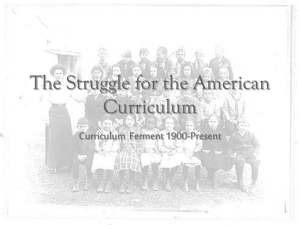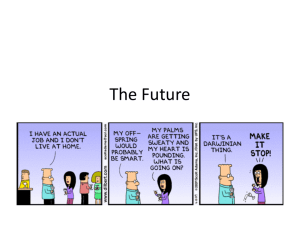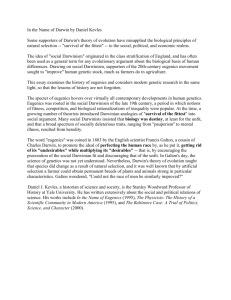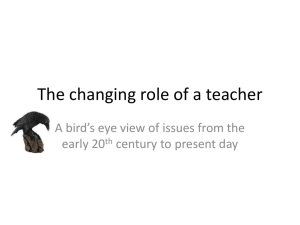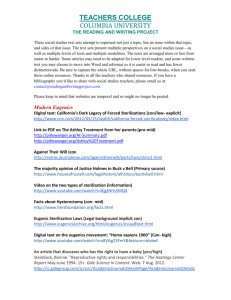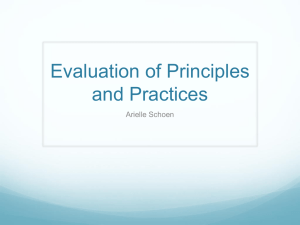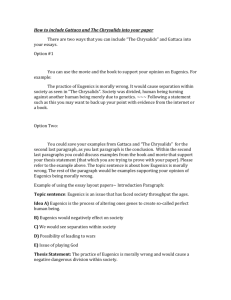The Curriculum 1900
advertisement
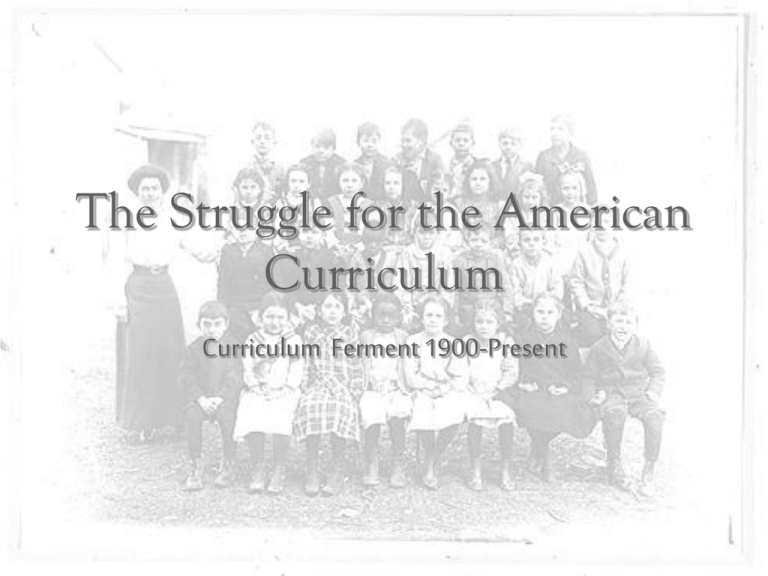
The Struggle for the American Curriculum Curriculum Ferment 1900-Present A New Vision of Schooling • 1800-1830 – The monitorial method • Teachers monitored or tutored students – Idiosyncratic – The Lancastrian system • A course of study – Units of work – Textbooks • McGuffy readers • Blueback spellers Standardization • The Lancastrian system led to a common (standardized) course of study • Textbooks gave teachers a “default” course of study • Grades and grade levels – William Harvey Wells- Chicago Superintendent of schools (18561864) Social Transformation • Social Change resulted in a radically altered vision of the role of schooling – The standardizing effect of the “Printed Word” • The penny press • Mass distribution of books – Utopian and Muckraking novels – Railroads • Travel broke down aspects of provincialism • Industrialization – the factory system – Immigration – The Panic of 1893 Edward Bellamy- author of “Looking Backward” The “Status Quo” 1890 • The Doctrine of Mental Discipline – Plato’s Theory of Forms • The world of ideas (forms) leads to perfect Truth and Good. It is eternal • The material world is imperfect and constantly changing – Certain subjects had the ability to strengthen • Memory, Reasoning, Will power, Imagination, Character – Metaphor- the mind is like a muscle- it needs the right kind of exercise. Christian Wolff 1828 Report to the Yale Faculty • A defense of the traditional curriculum – Jeremiah Day & James K. Kingsley • Two Main Functions of Education – “Discipline of the Mind” •The ability to think – “Furniture of the Mind” •Knowledge • Discipline of the Mind is most important James Kingsley Mental Discipline Curriculum • The Classics – – – – Greek Latin Great Literature The Trivium • Grammar, rhetoric, logic – The Quadrivium Arithmetic Geometry Astronomy Music Instruction • Recitation – Verbal memorization • Skill drills – Problem sets – translation • Strict Discipline – Necessary for a disciplined mind Reform • Theoretical problems – Why was the classic curriculum necessary for “mental exercise”? • Professional Educators – The National Education Association The Struggle for the American Curriculum • The Humanists – The Curriculum should reflect our Western Cultural Heritage • The Social Efficiency Educators – The curriculum should produce an efficient, smoothly running society • The Developmentalists – The Curriculum should be based upon the natural order of the development of the child • The Social Meliorists – The curriculum should bring about social change Humanists/Mental Disciplinarians • "Guardians" of ancient tradition tied to the power of reason and the finest elements of Western cultural heritage. • Humanists sought to reinterpret and preserve "revered" traditions and values in a rapidly changing society. • Charles W. Eliot – President of Harvard William Torrey Harris • Basic function of the school is for the development of reason • He sought to preserve the humanist ideal by incorporating into the curriculum the finest elements of Western civilization • The “five windows of the soul” – – – – arithmetic and mathematics geography history Grammar – literature and art The High School Curriculum • The NEA Committee of ten – Lead By Charles Eliot (President of Harvard) • Believed in “Modern Liberal Arts” • A curriculum that was “College Prep” • A curriculum that was “Life Prep” – Four courses of study were recommended but there was not distinction between college and life preparation Joseph Mayer Rice Rice undertook a survey of the public schools in1892. He published a series of muckraking articles in the magazine The Forum in 1892 and collected into the book “The Public School System of the United States”. His criticism mobilized parents against the corrupt politicians who, in practicing graft and patronage, had allowed many public schools to fall into lamentable disrepair. ,"It is indeed incomprehensible ," he wrote, "that so many loving mothers … are willing, without hesitation, to resign the fate of their little ones to the tender mercies of ward politicians, who in many instances have no scruples in placing the children in class-rooms the atmosphere of which is not fit for human beings to breathe, and in charge of teachers who treat them with a degree of severity that borders on barbarism.” Efficiency and Social Control • America at the turn of the century – President Teddy Roosevelt, in his address to the Governors at the White House in 1910, prophetically remarked that "The conservation of our national resources is only preliminary to the larger question of national efficiency.” – Becoming more “efficient” became a national obsession Social Control • One reason for the desire for efficiency was based upon a fear of social chaos. – Immigration brought about a thinly disguised racism •Edward Ross Social Control – “Society is always in the presence of the enemy”- i.e. the docile Slav, the street Arab, or the quiescent Hindoo. – Industrialization unchecked would corrupt the finer instincts of Americanism The Cult of Efficiency • Frederick Winslow Taylor and the Scientific Management movement • Taylor devised a system for getting greater productivity from human labor The Cult of Efficiency • For Taylor, there was always one best method for doing any particular job. • This method could be determined only through scientific study The Cult of Efficiency • Taylor believed that men was innately lazy and would always do less work than they were capable of unless they were strictly monitored • Effective management was necessary to bring about efficiency The Principles of Scientific Management • Time and motion studies must determine the elements of each man’s work – (eliminate all false, slow, and useless movements) • Workers must be selected and trained to do their job in the most efficient manner – (test them to see who is fastest with fewest errors) • There must be an equal division of work throughout the system – (division of labor insures quick and efficient training) • Management and workmen must work together with common goals in mind – Workmen are paid to “do” not to think The Principles of Scientific Management • The most important role for management was to: – Analyze – Plan and – Control the whole manufacturing process in minute detail Education and Efficiency School efficiency experts advocated programs of study that prepared individuals specifically and directly for the role that they would play as adult members of the social order. To go beyond what someone had to know in order to perform that role successfully was simply wasteful. Social utility became the supreme criterion against which the value of school studies was measured... Social Efficiency Movement • John Franklin Bobbitt • David Sneeden • Elwood C. Cubberley • Leonard Ayres • School Survey Movement – The Boise Study Administrative “Trust” • Housed in Education Departments in Colleges and Universities •Teachers College at Columbia University was the center for Administrative training on the East Coast •Stanford College of Education was the center on the West coast Elwood P. Cubberly • Cubberly was the first Dean of the College of Education at Stanford. •He wrote the curriculum and the textbooks that became the standard for preparing public school administrators •By the 1930’s, thousands of Superintendents and Principal had been trained by Cubberly. •He was a leader of the “School Survey” movement Franklin Bobbitt Proponent of platoon system developed by Superintendent Willard Wirt in Gary, Indiana. Bobbitt saw students as "raw materials" that need to be trained for future roles that they will perform in society they "should not be taught what they will never use”. That was waste. In order to reduce waste, educators had to institute a process of scientific measurement leading to a prediction as to one's future role in life. That prediction would then become the basis of a differentiated curriculum“"The elimination of waste in education" (1912); David Snedden Worked "to enlarge the scope of vocational education & to create socially efficient curriculum". Curricula built around specific needs of future jobs with objectives of teaching what was need to function in the future role. Viewed Junior High School as a time when differences in student abilities become apparent, therefore requiring differentiated curricula. Leonard Ayres Laggards in our schools (1909) Studied effects of retardation in schools (retardation = atypical progression through grades) Findings: "retardation represented a great loss in efficiency" this was because the 'college-repertory' curriculum that had held sway from so long needed to be replaced by a curriculum attuned to the needs of a new population and a new industrial order". He develops the Index of Efficiency for determining the productivity/efficiency of schools. Charles S Meek Boise in 1908 Boise 1919 Steunenberg Assassination Trial of the Century Defense Team Prosecution Team National Media Attention Boise Boosterism 709 Thatcher Tourtellotte and Hummel Plans for Boise High Boise High - East Wing Boise High Main and East Wing First Survey 1908 Dr. George Strayer – Teachers College Second Survey 1913 Dr. E. C. Elliot – University of Montana A “Practical” Curriculum A “Practical” Curriculum George D. Strayer Jessie Sears 1919 Boise Survey Efficient organization Efficient organization More Male Administrators Standardized Tests Spelling Results by School Retardation and “laggards” Eugenics Racial Purity I.Q. Testing Science and the Measurement of Man • Edward Thorndike – He was a student of William James – Whatever exists, exists in some amount and can be measured. Science and the Measurement of Man • Phrenology • Franz Joseph Gall – 1758-1828 Phrenology • The brain is the organ of the mind. • The mind is composed of multiple distinct, innate faculties. • Because they are distinct, each faculty must have a separate seat or "organ" in the brain. Phrenology • The size of an organ, other things being equal, is a measure of its power. • The shape of the brain is determined by the development of the various organs. Phrenology • As the skull takes its shape from the brain, the surface of the skull can be read as an accurate index of psychological aptitudes and tendencies Phrenology • Pseudo-Science – Racial bias – Cultural bias • Combined with Eugenics – A dangerous combination Eugenics • The social philosophy that the human race can be improved by encouraging human reproduction of the best people and traits and reduction of the reproduction of reproduction of the least desirable people and traits Eugenics Eugenics Eugenics Eugenics Eugenics In 1918, Idaho passed its first sterilization law, which applied only to institutionalized persons: “to prevent the procreation of the feeble-minded, insane, epileptic, moral degenerates, sexual perverts, who may be inmates of institutions maintained by public expense, by authorizing and providing for the sterilization of persons with inferior hereditary potentialities” The act was vetoed by Governor D.R. Davis in 1919, who doubted its scientific merit. In 1925, another act was passed that did not limit sterilization to those in institutions, and its was compulsory. The1925 law also created a State Eugenics Board. Eugenics Sterilizations may be performed on any person who is "feeble-minded, insane, epileptic, an habitual criminal, a moral degenerate, or a sexual pervert” if reproduction by such individuals would produce a child "having an inherited tendency to feeble-mindedness, insanity, epilepsy, criminality, or degeneracy, or who would probably become a social menace or ward of the state”. Eugenics Sterilizations began in 1932 and continued until 1963. 66% were declared “Mentally Deficient”. Measuring Intelligence • Alfred Binet – Asked by the French Ministry of Education to devise a way to identify children who needed special education – He devised a series of tasks and a scale to assess those tasks Louis Terman Created the “Stanford Benet” IQ test based upon IQ testing done in WWI. In 1923, created a series of “Achievement” tests for specific subject areas taught in public high schools. By the 1970s these become the tool for measuring school performance H.H. Goddard H.H. Goddard, said in his book Human Efficiency (1920) that government schooling was about "the perfect organization of the hive." He said standardized testing was a way to make lower classes recognize their own inferiority. Idiots, Like Imbeciles, Morons wearing a dunce cap, it would discourage them from breeding and having ambition. I.Q. Testing WWI I. Q. testing WWI • There were two forms of the test administered to the soldiers – Form “A” Alpha for those who were literate – Form “B” Beta for those who were illiterate Example Questions on the Alpha Test • 1. Crisco is a: • • • • A) B) C) D) patent medicine, disinfectant, toothpaste, food product • 2. Washington is to Adams as first is to . . . • 3. Christy Mathewson is famous as a: • • • • A) B) C) D) writer, artist, baseball player, comedian. Beta Test • On this section, test takers were asked, “What is missing? – Notice the cultural bias for many of the questions. What were the results? • The average mental age of White adults was 13 – This was the upper range for “moron” according to Goddard • The average MA for Southern/Eastern Europeans was 11 • The average MA for Black men was 10.4 Domination of Administrative Progressives • Structure of Schooling – Schooling broken into specialized parts •Kindergarten •Elementary •Junior high •High school •Vocational education •College •Graduate or professional school Domination of Administrative Progressives • Hierarchy of authority established • Administrative power is extended – – – – Power over budgets Curricular control Teacher evaluation- hiring and firing Workplace conditions • Teacher response – Compliance – Establishment of unions • NEA – Emma Flagg Young – Margaret Haley in Chicago Domination of Administrative Progressives • Social differentiation • Tracking by social/economic class – I.Q. and other standardized testing • Behavioral Psychology dominates • Schools operate as bureaucracies – Administrators • Central • School – Teachers » Support Staff B. F. Skinner Child-Study Movement/Developmentalists • Curriculum should allow for the natural order of development of the child. • Scientific data important with respect to different stages of child and adolescent development and also to nature of learning. • General agreement among the developmentalists was that schools thwarted the child's basic need for activity by treating children as passive receptacles and presenting them with a program of studies that ran contrary to their natural tendencies and predilections G. Stanley Hall • Schools are in need of drastic reform in order to bring their program of studies in line with scientific findings about the nature of child life • The contents of children's minds (1883) – The child recapitulates in his or her individual development the stages that the whole human race traversed throughout the course of history (ontogeny recapitulates phylogeny) • Play until the age of eight • Read myths and legends during the “savage” stage. – “The guardians of the young, should strive first of all to keep out of nature's way, and to prevent harm, and merit the proud title of defenders of the happiness and rights of children.” Child-Study Movement William Heard Kilpatrick • Foundations of Method (1925) – The Project Method- “Education [should] be considered as life itself and not as a mere preparation for later living.” – The child was the key to revitalized curriculum – Curriculum planning starts with life... with subject matter brought in only incidentally as it bears on real problems – Learning is synonymous with purposeful activity Social Melorists • Individuals have a moral responsibility to work for social justice • Schools are a major force for social change and social justice. • Schools were the vehicles to create a new social vision and to empower the young Lester Frank Ward Dynamic Sociology 1913 Social Meliorists • Schools are a major force for social change and social justice. Schools were the vehicles to create a new social vision. • George Counts – Response to Sumner-“The Absurd Effort to Make the World Over”(1884) with “Dare the School Build a New Social Order?” (1932) • Harold O. Rugg – Social Reconstructionism • Boyd Bode – Progressive Education Association George S. Counts - Social Meliorist • Dare the School Build a New Social Order? – He was among the first to reflect on the undercurrent of uneasiness about American society during the 1930’s and connect it to American schools – He argued that the American school system preserved and maintained the existing social order • Counts challenged schools to meet the social issues of the day John Dewey • Dewey tried to synthesize the positions of the four interest groups • Humanists • Developmentalists • Scientific Efficiency Educators • Social Meliorists Dewey began as a philosopher/psychologist/sociologist • Pragmatism/Instrumentalism – Philosophy must be useful – Psychology must be about the individual and the social – Sociology must be used to improve social institutions Dewey’s Problem-Solving Approach • Avoid “Either-Or” positions • Always consider the consequences of a decision • Experiment – The scientific method • Identify the problem • Create an hypothesis • Gather evidence • Experiment • Accept/reject/revise hypothesis Purpose of Education • What is the “problem”? – Industrial organization has replaced the home and the neighborhood • Schools must change to provide learning that is: – Real – Immediate – Able to initiate children into the social world • Create a miniature community Criticism of Humanist Curriculum • He rejected the idea that the interests of the child should be subordinated to future “rewards” • He rejected Harris’s “five windows to the soul” because: – They didn’t address human experience in a unified way- they were formal, artificial, separated – They were presented as “given” and “finished” Criticisms of Developmentalists • The Culture-Epochs model was too simplistic • The curriculum was imposed in the same way as the humanist curriculum Criticisms of Scientific Management • The school is not a factory producing a product • Not all children learn in the same way at the same time • Bureaucratic processes are dehumanizing Criticisms of Social Meliorism • Schools are not just an institution for “social engineering” • There are aspects of the current social order that should be retained The Dewey School • A “Laboratory” school • “Occupations” – Evolution of basic social activities • Growing food • Constructing shelter • Making clothing – Traditional subjects taught by “doing” not telling • Harmonize individual and social ends The Dewey School • A “Laboratory” school • “Occupations” – Evolution of basic social activities • Growing food • Constructing shelter • Making clothing – Traditional subjects taught by “doing” not telling • Harmonize individual and social ends The Dewey School • A “Laboratory” school • “Occupations” – Evolution of basic social activities • Growing food • Constructing shelter • Making clothing – Traditional subjects taught by “doing” not telling • Harmonize individual and social ends Colonel Francis Parker Applied Dewey’s principles to a create a Progressive school in Chicago. Dewey sent his own children to Parker’s school Pockets of Progressivism • New York 1920-1940 – The Activity program •An experimental program involving 69 elementary schools and over 70,000 students – – – – Child centered Flexible scheduling Activity or project based curriculum Freedom for teachers to determine instruction – Dalton Plan •High school – Individualized learning programs Pockets of Progressivism • Denver 1920-1940 • The eight year study – Experimental design •Core curriculum (areas of living) – – – – Personal living Immediate personal/social relationships Social/Civic relationships Economic relationships •Integrated, project-based – Teachers controlled the curriculum The 1950s-1960s • Post World War II saw a growing criticism of American Education • Sputnik (1957) gave evidence that Russia was doing a superior job of educating it’s youth. • Cold War implications 1950’s Humanists after Sputnik (Soviet satellite launched in 1957) • Curriculum reform projects are from academic departments in major universities. • The attempt to replace the academic subject as the basic building block of the curriculum was brought to abrupt end • Longstanding emphasis on local efforts at curriculum change replaced by pattern of centrally controlled curriculum revision. • “Back to Basics” movement The 1950s-1960s • Arthur Bestor – “Educational Wastelands” • Rudolf Flesch – Why Johnny Can’t Read • Admiral Hyman Rickover – Education and Freedom The 1950s-1960s • Admiral Hyman Rickover – Education and Freedom Dewey's insistence on making the child's interest the determining factor in planning curricula has led to substitution of knowhow subjects for solid learning and to the widespread tendency of schools to instruct pupils in the minutiae of daily life--how to set a table correctly, how to budget one's income, how to use cameras, telephones, and consumer credit--the list is endless. Add to this that Dewey insisted the schoolroom must mirror the community and you find classrooms cluttered with cardboard boxes, children learning arithmetic by keeping store, and education stuck in the concrete and unable to carry the child from there to abstract concepts and ideas. Our young people are therefore deprived of the tremendous intellectual heritage of Western civilization which no child can possibly discover by himself; he must be led to it." Influence of the Federal Government • 1954- Brown vs. the Board of EducationTopeka, Kansas – Rejection of the “separate but equal” clause • 1958- National Defense Education Act – Federal funds to improve science, math, foreign language instruction • 1965- Elementary and Secondary Education Act – Johnson’s “War on Poverty” (Title 1) Advocates of “Child-Centered” Progressive Education • • • • • • • • • A.S. Neil (Summerhill) Joseph Featherstone John Holt James Herndon Jonathan Kozol Herbert Kohl Vito Perrone Deborah Meier Alfie Kohn Today Does Progressive Education Exist? • Pockets on the margins • Hybrids – Cooperative learning – Project based education – Middle School model • James Beane • Current research from Cognitive and Developmental Psychology • School “Choice” models – Charter schools – Alternative schools
